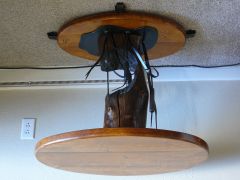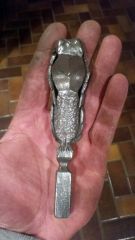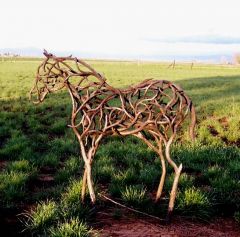-
Posts
202 -
Joined
-
Last visited
Content Type
Profiles
Forums
Articles
Gallery
Downloads
Events
Everything posted by john_zxz
-
Yes you understood right, but I wonder if the dish is solidely attached to the arm or just sitting loosely on it.
-
Hi, I have a problem with candle spikes ( sorry I don't know the name of that part, you'll see in the picture what I'm talking about). How in the old days did they make this part, the small spike where the candle sits on. When there is a scroll under the pan, you can make a tenon and rivet it from under, but like in the picture, I don't see how without arc welding. If someone has a clue, I'm taking it because I want to make candelabras like this one and I don't want to tack it. My stick welder, even at the lowest amperage is too powerful and burns a hole in half a second in a pan of 16 ga steel.
-
I have one. It is good to cut sheet metal (mine is 16 ga) and with little more effort, you can cut 1/8" plate. I never tried plate larger than 2". There is also a hole to cut 1/2" rod in the middle of the blade. I can cut easily 3/8" bar in that same hole but I must say that my shear isn't solidly bolted on a heavy bench. It is only bolted to a wood beam on the floor, so I can't work with 1/2". IMHO it is good for the price.
-

Some hanging wall brackets and hurricane candle holders.
john_zxz replied to P. Bedard's topic in Member Projects
I like them very much! Nice work. -
Congratulation!
-
Looks fine to me. The edges seems sharp. Go for it if you live near.
-

Beaver chewed log table with cattails
john_zxz commented on prof's gallery image in Member Galleries
-
I tried the vise jaws trick and it worked. No need to buy or make new tool. Thanks for the replies guys!
-
Hi, my project is to replicate an old (not a lot but still) lock for a cupboard. This subject is more for the locksmithing area but didn't know where to post it. I am able to make all the parts of the lock except the rectangular holes. The steel is like 18 or 16 ga. I made a small rectangular punch and tried to punch the holes over a piece of endgrain wood but all I got is a huge bulge and a lot of mess. Nothing near a clear punching. My question is, does any of you have ever tried to punch holes like that in steel sheet, and if so, how did you achieve it? My other idea is to drill a series of small holes and then file them but if punching can be done, I would prefer it. John_zXz
-

strange way to use an anvil
john_zxz replied to john_zxz's topic in Anvils, Swage Blocks, and Mandrels
Dodge, your explanation sounds very good to me. You may be right about this. Thanks. -
I found this painting on an Art website (http://www.artfindin...SMITH/8633.html) I you look closely, you'll notice that the anvil is upside down on the stump. Any clues for this setup except that the real face would have been damaged?
-

Idle talk, Who is your favorite Blacksmith from the movies?
john_zxz replied to PCornett's topic in Everything Else
My favorite blacksmith scene is from the movie: Dark Kingdom: The Dragon King. From the Opera cycle: Ring of Nibelungen. One of my favorite medieval movie because of this scene.... and because Kristana Loken is playing in it too ;) -
-
-

Blower inside coal forge chimney
john_zxz replied to john_zxz's topic in Chimneys, Hoods, and Stacks
Thanks for your replies everyone. I think I'm gonna change the chimney pipe size from 8" to 10". That will certainly help better than adding a pipe with a blower. Grant, the link is very interesting and has nice pictures too. Thank you. -

Blower inside coal forge chimney
john_zxz replied to john_zxz's topic in Chimneys, Hoods, and Stacks
Ok, I guess I will try to get more air circulation in my shop then. Thanks for your advices guys! -
Hi, I recently came accross an article on how to build a coal forge. In the picture, the blower pipe is divided in 2 so the draft goes underneath the forge and inside the chimney. In the description it says that it helps to draw the smoke into the chimney. Anyone ever tried this method? I want to give it a try, mostly for the ashes in the air, as the anthracite I use doesn't smoke, but wanted to know if anyone has ever tested it before. I'm having difficulties to upload the picture so I put the link here: http://www.vintagepr...shop-forge.html John_zXz
-
Thanks for the link. Nice tip too, I will do this as a routine for sure.
-
Thanks for your answers. I will still give a try with propane. Coke is hard to find in my location and and I don't like charcoal that much because of the sparks. I usually work with stock from 1/4" to 3/4" square, some flats like 316"X 3". No big scrolls. I will keep my coal forge for larger pieces. I would like to do damascus in the future too so the forge will have to be able to heat at least 1"X 2" square.
-
Hi, I've been blacksmithing with solid fuel since 10 years and want to switch to propane forge to prevent any health issue in the future (I lost my grandfather and my young aunt cause of lung cancer recently). The problem is, I know almost nothing about gas forges. I read a little on the internet but wanted to get advices from you guys. I would like to purchase a propane forge to do general blacksmithing, including forge welding. I was looking for this model: http://www.mightyfor.../TheMighty.html (it is canadian so I can save on shipping) I don't know if 2 burners are too much but the specs says that they can be individually controlled so I guess it can be turned into single burner if I want. Any of you had the chance to try it or have some suggestions on any other brands under 800$ that fit my needs? Also by your experience, is it more effective to heat with a cylinder forge or with a square shaped one. I don't want to build a gas forge myself because I'm afraid of things with gas, if I make a mistake in the building process... etc I never touched torches and things like that. Waiting for your advices John_zXz
-
Thank you John B for the pictures and explanations on your link. After a brief reflexion I will use rivets and collars. The middle part of my candle stand will look better with collars, for the rest, I will use rivets. I will make a tool like yours. Thanks for the idea. I'll post some pictures of the finished project when it will be done.
-
Thanks for your replies everyone. I guess I'll go with the collar then. It will be easier than riveting as the scrolls are a bit small. Thanks for your ideas. John_zXz
-
Hi, I have a project that I want to forge but I have a problem with it. I want to make a candle stand which have a couple of small scrolls. Habitually, I weld them with my stick welder but for this project, I want it to be done " in a traditional way". I want to rivet them. I'm okay with riveting (when I can hit the head directly with my hammer) but when the scrolls are already formed, how can I hit the head without deforming the scroll? I never seen anyone doing this and never saw a picture or drawing in my books. Is there a tool that I can make to do that? If someone has a photo, a drawing or a link so I can see how it is done, thank you in advance. John_zXz
-
Ok! Great That is more logical than my explanation... Thanks for the fast answer guys.
-
Hi I recently saw a type of coal forge that I never saw before. It's like the hood is right over the fire but has no chimney...My question is, how does it works? When I saw this, I first thought that the hood was connected with the air entrance of the blower so that it can suck smoke directly from the hood and blow it in the fire from under... but not sure if it works like this. If anyone as explanations, please tell me. I'm very interested in this type of coal forges. John_zXz



